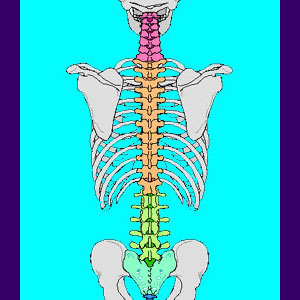
Middle back pain is the most rarest symptomatic expression of any chronic dorsalgia location. The degenerative processes are not overly active in the middle back, since that area of the spine is not flexed or bent to the same degree, or as often, as the upper and lower regions. The discs in the thoracic spinal region do not get the same day to day abuse as those in the cervical and lumbar areas. The osteoarthritic processes also do not often gain a firm hold here.
Remember that the thoracic region is designed for support and protection, as well as being structurally reinforced by the rib cage. All these factors help to minimize the occurrence of structural mid back pain syndromes. When middle back pain does occur, it often presents a enigmatic situation for caregivers, who frequently have difficulty linking it to any logical source.
This discussion focuses on middle back pain syndromes and some of the lesser known facts surrounding them.
Middle Back Pain Facts
The middle spine is designed to safeguard our internal organs and provide stability to our skeletons. It is not meant for flexibility and does not suffer the effects of a lifetime of movement in most patients. Therefore, degenerative back pain and herniated discs are rare occurrences in the mid spine.
Most middle spine symptoms are muscular in nature, regardless of whether they are purely structurally sourced or caused by a nonstructural process, such as in the case of tension myoneural syndrome. There is a good chance that muscular mid back discomfort will go away by itself.
Mid spine pain can also be the result of some serious traumatic injury, such as a car collision, sports accident or fall.
Soft tissue conditions usually require only time, not treatment, in order to heal 100%. However, other structural reasons for pain may require targeted therapy from a qualified specialist.
Just remember that an accurate diagnosis is the most important factor to achieve, since without it, treatment has little, if any, hope for lasting success.
Mid Back Pain Discomfort
There are many cases of middle back pain that occur after successful treatment of a lower back disorder. This often takes place after a surgery is performed to correct the lumbar problem. In these scenarios, the new middle spine pain can be caused from 2 main reasons:
If the lower back pain was cured by a spinal fusion, that fusion might be applying pressure to the vertebrae above it in the mid back region. This might be the cause of the discomfort and often sends the patients on a terrible journey of multiple surgeries, progressively reducing their overall functionality while rarely curing the pain.
The other cause might be that the lower back pain was cured by the power of a strong placebo reaction. Any type of back pain treatment, including surgery, can be the strongest placebo available!
The true cause of the pain might still exist and is now creating a symptomatic condition in another location. This often denotes an underlying mindbody issue sourcing the complaint to begin with.
If you have chronic mid back pain, I would recommend learning more about the potential psychoemotional causes of your pain. This is particularly useful for patients who do not have significant explanatory thoracic issues which might be sourcing the symptoms. Even more so, if they have already attempted many traditional therapy options without success and are beginning to lose hope of ever finding a cure.




